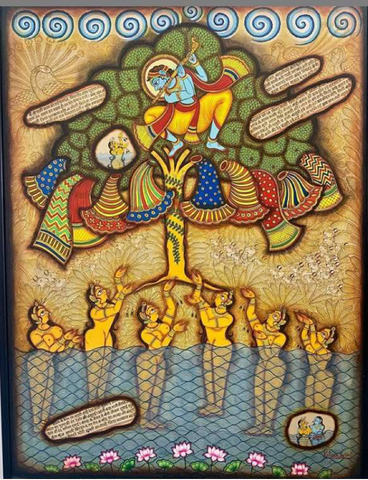The Phad painting tradition is widely prevalent in the western state of Rajasthan. It is a folk heritage which is part of both the tangible and intangible aspects of our heritage. Traditionally, the Phad paintings were religious and seldom done commercially. However, today we see its commercialization as it is not possible for the artists to survive solely on the basis of commissions from religious Phad. There has been no literary record of the development or even the mention of Phad in the court traditions of the provincial courts of Rajasthan. This is because these paintings were not made for artistic purposes but were religious in nature.
Phad paintings are the most complex and elaborate of the pictorial devices used for story telling in India. They were traditionally used as movie scrolls, with special emphasis on each scene. They narrated the stories of local folk deities such as Pabuji, Devnarayan, Ramdev pir, Dharamraj, etc. These local heroes are different from each other, but are worshipped because of the similar reason that they have all protected their cattle.
The history of Phad paintings date back to 700 years and are of pure indian subcontinental origin. The chitera, or the professional Phad painters developed the art form in the district of Pur, near Bhilwara, Rajasthan. The traditional painters migrated to Shahpura in the 16th century and then to the city of Bhilwara in the 19th century.
The word Phad is derived from the hindi word ‘pad’ which means ‘kathan-wachan’ or ‘to read’. This in turn is derived from the Sanskrit word ‘patt’ which in the local dialect means ‘to fold’, which is exactly how it is stored.
The padh paintings are in conjunction with the all-night performances, unrolled only after sunset. It is believed that the first Phad was commissioned by Chochu Bhat, who commissioned the Phad painting at the request of Devnarayan’s maternal family in Malwa as they wanted something to remember of him. Eventually everyone started worshipping him, and started adding more events to the story and it became longer and more detailed. Hence developed the enormous scroll paintings of Phad.
The Phad paintings are stylistically similar to the Malwa paintings since the region has been historically important
Malwa has been historically important for the Phad chitera community as it was considered to be Devnarayan’s maternal place. Hence, there is a stylistic similarity between the Malwa paintings and the Phad paintings. The prominent similarities can be seen in the architectural traditions. The demarcation of interiors is done using plain and fluted domes, the interiors are distinguished using arches. The interior settings also have similar elements such as bolsters, curtains and beddings. There is a similarity even in the depiction of the physical elements such as protruding eyes and the attire of women. The major difference between them lies in the fact that the Malwa paintings have independent miniature narrative scenes and follow a different thematic depiction.
Themes
The present Phads mainly depict five deities – Devnarayan, Pabuji, Krishna, Ramdala and Ramdeo. However, the earlier Phads also illustrated the stories from the life of Gogo Chauhan, Amar Singh Rathore, Prithviraj Chauhan, Teja ji and many others.

Ramdala Phad
Today the themes also include topics on social awareness such as saving water and voting during the elections.


Characteristic features
Unlike the Telangana or Bengal scroll paintings, the Phad paintings are not chronologically sequenced. The episodes are scattered all over the place. The pictorial scheme of Phad is designed to allow scope for a composite performance of the oral narrative, as well as dance and music. However, there is still a pattern in the distribution of episodes in the Phad paintings, which can be noticed if we divide the painting into four equal halves.
There is no sense of time in the Phad paintings. The scenes have elements which suggest the past, present and the future elements together in a single scene.
Every inch of the panting is covered with figures. There is a grand construction of the pictorial space.
The faces are shown in profile, and the figures are always adjusted according to their social hierarchy.
The scenes are demarcated using creepers, borders, rivers, trees and buildings as dividers.
The vegetable and mineral based colours are used in Phad paintings. The colours are always applied in a sequence – yellow non-permanent colour, saffron, green, brown, vermilion, blue and black. Each colour has its own specific use.
Today the Phad artists are trying different techniques, such as painting independent scenes, moving on from only paintings to clocks, crockery, jewellery and even wedding trousseau. The artists are also experimenting with the colour combinations, making them more aesthetic.

Interesting fact – Recently a Phad image was used in the google doodle of the 74th independence day which celebrated the arts and culture of India.

FURTHER READS
- Indian miniatures and folk paintings by Mildred Archer
- Indian folk and tribal paintings by Charu Smita Gupta
- The earthen drum by Pupul Jayakar
- Unknown India by Stella Kramrisch
Written by ~ Misha Jaswal






















